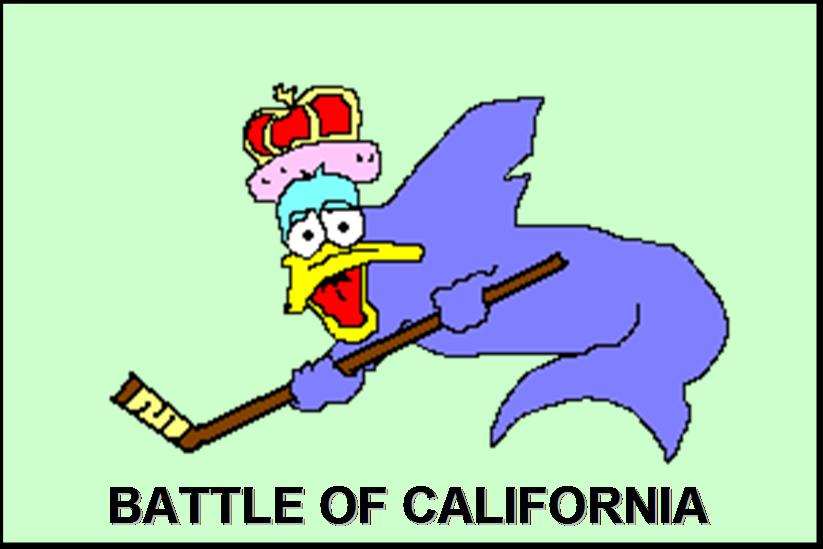Data Exploration: Goals and Shots
Enough with the poetry already! Time to dig in some numbers!
Inspired and enabled by mc79hockey and his data-grabbing wizardry, I decided to get a bit nerdy and start playing with NHL.com official stats. Specifically, I took a look at Anaheim's regular season and their shots-on-goal. (I pulled empty-net goals, because I think the point I want to make about this is really about goalies and not about empty nets.)
First off, here are these Duck goals sliced by shot type, as tracked by NHL.com. I don’t know why the Ducks didn’t score any (or try many) wrap-around goals, but I can’t think of an incident off-hand to say that this data is wrong.
| Shot Type | Goals | Shots | Percentage |
|---|---|---|---|
Slap | 83 | 1,110 | 7.48% |
Wrist | 61 | 637 | 9.58% |
Snap | 38 | 382 | 9.95% |
Backhand | 20 | 258 | 7.75% |
Tip-In | 39 | 154 | 25.32% |
Wrap-Around | 0 | 34 | 0.00% |
Total | 241 | 2,575 | 9.36% |
Next comes distance, as measured in feet. Andy Grabia at BoA has noted in a rather long post that this distance is measured from the back boards, not the goal line. Whatever, the point is that it is measured.
| Distance (feet) | Goals | Shots | Percentage |
|---|---|---|---|
0 - 12 | 62 | 282 | 21.99% |
13 - 24 | 106 | 745 | 14.23% |
25 - 36 | 31 | 519 | 5.97% |
37 - 48 | 24 | 508 | 4.72% |
49 - 60 | 16 | 410 | 3.90% |
61 + | 2 | 111 | 1.80% |
Total | 241 | 2,575 | 9.36% |
I didn’t bother separating 5-0n-3 or 4-on-4 or any other such useful nonsense, but here’s the layman’s take on man-advantages.
| Strength | Goals | Shots | Percentage |
|---|---|---|---|
PP | 87 | 601 | 14.48% |
ES | 146 | 1,848 | 7.90% |
SH | 8 | 126 | 6.35% |
Total | 241 | 2,575 | 9.36% |
Measuring time elapsed is trickier, and certainly has kinks. This 'rebound' tracker really just tracks the time elapsed (a) from the start of the period, or (b) from the last shot taken. I also failed to do some useful stuff like think about stoppages in play, but the point really is about rebounds.
| Time Since Last Shot | Goals | Shots | Percentage |
|---|---|---|---|
within 3 seconds | 35 | 97 | 36.08% |
within 30 seconds | 73 | 675 | 10.81% |
within 60 seconds | 43 | 497 | 8.65% |
more than 1 minute | 90 | 1,306 | 6.89% |
Total | 241 | 2,575 | 9.36% |
And for sure, it’s separable by shooter, of which here’s a glimpse:
| Shooter | Goals | Shots | Percentage |
|---|---|---|---|
Teemu Selanne | 38 | 265 | 14.34% |
Andy McDonald | 34 | 229 | 14.85% |
Other Forwards | 138 | 1,430 | 9.65% |
Scott Niedermayer | 13 | 181 | 7.18% |
Francois Beauchemin | 8 | 121 | 6.61% |
Other Defensemen | 10 | 349 | 2.87% |
Total | 241 | 2,575 | 9.36% |
This last one took me a little while, as I still depend on some manual-ish data manipulation, but I tracked what the score was at the time of each shot.
| Anaheim Margin | Goals | Shots | Percentage |
|---|---|---|---|
Down by 2 or more | 32 | 293 | 10.92% |
Down by 1 | 49 | 538 | 9.11% |
Tie Game | 89 | 1,004 | 8.86% |
Up by 1 | 41 | 437 | 9.38% |
Up by 2 or more | 30 | 303 | 9.90% |
Total | 241 | 2,575 | 9.36% |
So my point is really not about shots, but about saves and save quality. A Selanne power play tip-in is not the same as a Vishnevski short-handed wrap-around, and a good system to really measure goalies and their save percentages should include probably all six of these factors.
“But Sleek! All you’ve done is show me singular cuts of one team’s data. Isn’t there some correlation going on here, and wouldn’t it be more statistically relevant to run this for 30 teams?”
Yeah, yeah, those are future posts, when I can kind of work out the kinks in my dinosaurish data skills. But I’m getting it going, boys.
Maybe you’re looking at a future Islanders G.M.









5 comments:
I recommend you read:
A logistic regression approach to assessing NHL shots on goal
BTW: It's a lot easier to do if you use a database like MySQL...
I should note: Being tougher to score while tied is the result of good goaltenders playing better under pressure (guess). Also it would appear easier to score when up (likely do to good teams scoring more in general...). That being said score differential is one of the less useful predictors.
Also be careful:
Francois Beauchemin
8/121 = 6.61%
binomial error = sqrt(8*113/121) = 2.73. 2.73 * 2 = 5.5 so 8 +/- 5.5... Which is pretty huge, in other words I'm not sure he shoots better, he might've been lucky...
I've read that before, and should probably give it another look.
But at first glance, it doesn't consider shooter, which surely needs to be a factor also.
I have to fix my data up some* and run it for 30 teams, but I got some statistical software at my disposal at work, and we'll find out what matters most for shot quality (I hope).
* I didn't capture 'goaltender', which is a weakness.
Unfortunately, I think this type of activity and knowledge would actually disqualify you from the NYI GM position...
Watching pucks fly by you or trading away future superstars seem to be the more efficient paths to General Manager-dom on the Island.
When looking at the shot distance you also need to remember that more than 25% of the team's goals were tip-ins. The original shot/pass that was tipped was likely from a greater distance, so don't get all upset when you see your D shooting from 61+ feet just because they're only likely to score 1.8% of the time.
When looking at the shot distance you also need to remember that more than 25% of the team's goals were tip-ins.
That's a misstatement. Tip-ins went in at at 25% success rate (goals/shots), but only constituted 16% of the non-empty-net Duck goals.
Still, the main point is valid.
Post a Comment